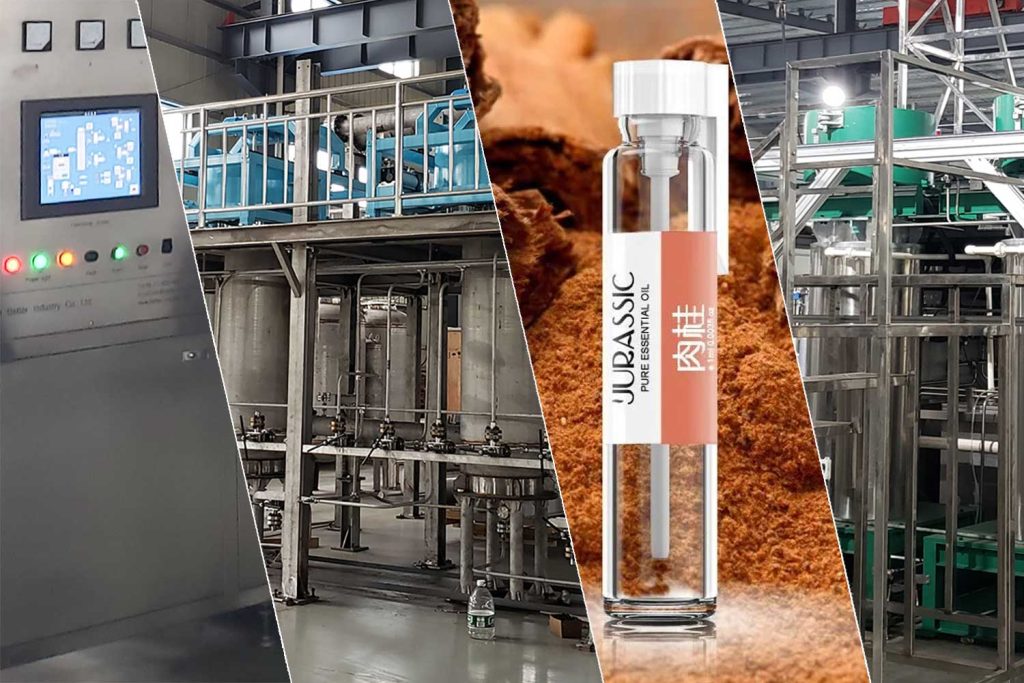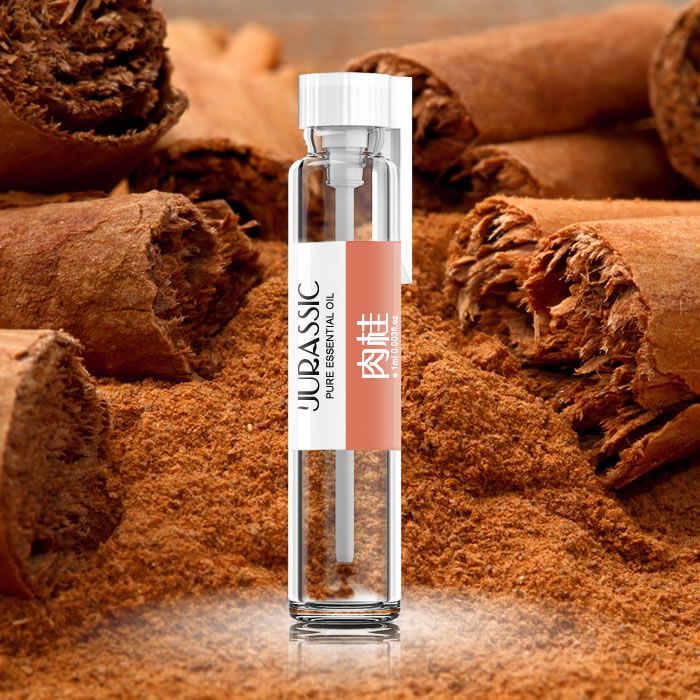Cinnamon is a spice commonly used in food flavorings and aromatherapy oils. The essential oil of cinnamon is extracted from the bark and leaves of cinnamon tree plants. Supercritical CO2 extraction is becoming a popular method for extracting essential oils from cinnamon due to its efficiency and preservation of active ingredients. In this article, we will discuss the supercritical CO2 extraction method for cinnamon essential oil, its benefits, and the optimal extraction conditions.
CO2 Extraction Process for Cinnamon Essential Oil
Supercritical CO2 extraction releases essential oils from cinnamon using carbon dioxide (CO2) at high pressure and low temperature. Supercritical CO2 extraction of cinnamon essential oil can yield up to 2.3% of the oil’s weight. The extracted essential oils are rich in cinnamaldehyde, cinnamyl acetate, and eugenol, which contribute to the exotic and sweet aromatic properties of cinnamon essential oil.
The following table shows the optimal process parameters for supercritical CO2 extraction of cinnamon essential oil:
| Process Parameter | Value |
|---|---|
| Temperature | 40-50°C |
| Pressure | 200-400 bar |
| CO2 Flow Rate | 20-30 kg/h |
| Extraction Time | 2-3 hours |
| Yield | 1.5-2.3% |
To optimize the extraction yield and quality of the extracted essential oil, the temperature should be between 40-50°C, and the pressure range should be between 200-400 bar. CO2 flow rate should be carefully selected between 20-30 kg/h, and the extraction duration should be between 2-3 hours. These parameters will ensure a yield between 1.5-2.3% of the essential oil.
Advantages of Supercritical CO2 Extraction of Cinnamon Essential Oil
Supercritical CO2 extraction of cinnamon essential oil has several advantages over traditional extraction methods. Firstly, it is a safe, non-toxic, and environmentally friendly technique. Secondly, this method is highly efficient and cost-effective and produces a high-quality extract with minimal degradation of the active components. Cinnamon essential oil extracted using supercritical CO2 is also free from any solvent residues, making it ideal for use in the food and cosmetic industries.
CO2 Extraction Process of Cinnamon Oil
- Extraction temperature: 40 ℃;
- Extraction pressure: 350 bar;
- Extraction time: 3h;
- Separation temperature: 55 ℃;
- Separation pressure: 90 bar;
- CO2 flow rate 30 kg / h;
- Materail bulk density: (0.44 ± 0.02) g / ml.

Using orthogonal test design, the extraction yield of cinnamon oil is the evaluation index, which affects the four-factor variables of extraction yield (temperature, pressure, CO2 flow, bulk density), each factor takes three levels, according to orthogonal Experimental design L9 (34).
Supercritical co2 extraction of cinnamon for 2 to 3 hours basically reaches the extraction limit, and the extension of time has little meaning, and in dynamic extraction, co2 has good fluidity, high solubility, and strong ability to carry substances, for the extraction of common plant materials.
3~4h has basically reached the extraction limit, so this experiment selected a fixed 3h as the extraction time and did not further study the influence of time factors.
4 Parameters Affecting Cinnamon Oil CO2 Extraction Efficiency
Extraction temperature
At a certain pressure, the extraction temperature affects the extraction yield by affecting the combination and dissociation of organic molecules and CO2 molecules.
The extraction temperature also affects the overall thermal effect of the extraction process.
On the one hand, the higher the extraction temperature, the smaller the density of CO2 fluid, the worse the solubility of organic matter, and the lower the ability to carry substances.
On the other hand, the higher the extraction temperature, the faster the fluid mass transfer speed. The former is not conducive to extraction, and the latter is conducive to extraction.
In this experiment, through the orthogonal experiment, we can know that the range of temperature factors is the smallest, which means that in this experiment, compared with other factors, the temperature has the smallest influence on the extraction rate of Cinnamon by supercritical CO2 extraction.
Combined with the orthogonal experiment, the extraction temperature of 40 ℃ is better.
Extraction pressure
The polarity of supercritical co2 increases with the increase of pressure, which affects the binding capacity of supercritical co2 and solute.
In this experiment, the range of pressure factors is the largest, which indicates that the pressure has the greatest influence on the extraction yield of cinnamon.
The results show that with the increase of pressure, the extraction yield also increases.
Considering the higher pressure, the cost and power consumption of extraction equipment will increase greatly.
Therefore, from the perspective of practical application, 35MPa can meet the requirements, so the extraction pressure of 35MPa is better.
CO2 flow
With the increase in co2 flow rate, the extraction yield is decreasing under different extraction co2 flow rates.
This is mainly because the increase in the co2 flow rate reduces the contact time between co2 and raw materials, which is not conducive to the improvement of extraction yield. On the other hand, through the knowledge of chemical kinetics, we know that the increase in co2 flow rate will accelerate the speed of the material layer and improve the mass transfer rate, which will improve the extraction speed.
It can be seen from this experiment and previous exploratory experiments that under various operating conditions, supercritical CO2 extraction of cinnamon for 2-3H has basically reached the extraction limit, and the extraction rate has no obvious change in unit time after prolonging the time.
Moreover, in dynamic extraction, the capacity of CO2 fluidity, solubility, and carrying substance has been very good, and CO2 flow will increase CO2 consumption and cost, so by increasing dioxygen It is not advisable to increase the extraction speed by the flow rate of carbonization.
Considering comprehensively, the co2 flow rate of 30kg / h is better.
Raw material bulk density
Under different packing densities of raw materials, with the increased packing density of raw materials, the extraction yield decreases. This is mainly because the excessive packing density of raw materials makes the permeability worse so that CO2 can only pass through the material layer along the route with low resistance, and the material is broken down (many small holes are produced), which makes the extraction significantly uneven.
At the same time, under the condition of high packing density, the moisture content in cinnamon powder is fast due to the effect of pressure. It will affect the extraction of cinnamon oil and increase the bulk density, which means it will take more time and energy to crush the raw materials.
Therefore, it is suggested that the bulk density of raw materials should be (0.44 ± 0.02) g / ml.
The optimization co2 extraction process
Through the comprehensive analysis of the orthogonal test results, better technological conditions were obtained:
Extraction temperature 40 ℃, extraction pressure 35 MPa, CO2 flow rate 30 kg / h, bulk density (0.44 ± 0.02) g / ml.
The results showed that the extraction rate of cinnamon oil was 5.8% – 6.0%, the aroma of cinnamon oil was good, the appearance of cinnamon oil was brownish red, the color of cinnamon oil was darker than that of conventional steam distillation, the extraction rate of cinnamon oil by supercritical co2 extraction was more than 5 times of that by steam distillation, and the extraction time was also greatly shortened.
The temperature is low, and the whole extraction and separation process is carried out in a dark field, avoiding the decomposition, precipitation, and other changes in the conventional extraction process, and maintaining the original characteristics of the components in cinnamon oil to the greatest extent.
CO2 extraction process VS Steam distillation

Supercritical co2 extraction is a better technology to extract and separate plant essential oil.
Using supercritical co2 extraction to extract cinnamon, the oil yield is more than 5 times that of ordinary steam distillation, and the extraction time is shortened.
The obtained oil has natural color and pure fragrance.
In the range of the experimental conditions, the optimization-operating conditions were:
Extraction temperature 40 ℃, extraction pressure 35 MPa, CO2 flow rate 30 kg / h, bulk density (0.44 ± 0.02) g / ml. This method is easy to operate, safe, and non-toxic, and there is no residual solvent problem, so it has a good development prospect.
Conclusion
Supercritical CO2 extraction is a highly efficient and effective method for extracting cinnamon essential oil. It offers several benefits over traditional extraction techniques, including its safety, environmentally friendly nature, and the production of high-quality extracts. Optimal extraction parameters, including temperature, pressure, CO2 flow rate, extraction duration, and yield, are crucial for achieving high-quality cinnamon essential oil. With proper controls and conditions, the supercritical CO2 extraction method will continue to play an important role in the production of cinnamon essential oil for the food, cosmetic, and aromatherapy industries.